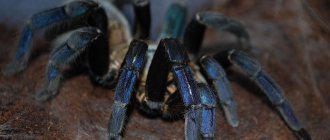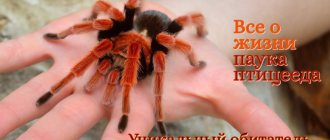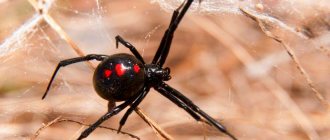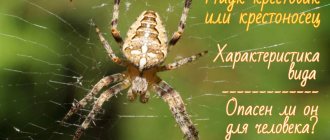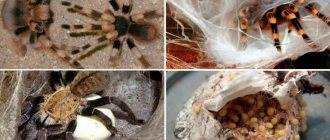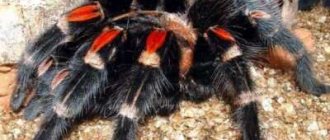More and more people are choosing exotic animals as pets. Interest in such an unusual pet as the tarantula is rapidly increasing. Before going to a pet store, you should familiarize yourself with the characteristics of such animals and the rules of keeping.
Keeping a tarantula spider at home
These arthropods are extremely unpretentious and can be bred in captivity without problems, so they have long become popular pets. The tarantula spider should be kept at home by adhering to the following rules:
- The temperature in his home should not fall below +25ºС. To do this, use a heater or thermal mat.
- Some species that live naturally in the tropics require a humidity level of 85%. You can maintain the required level using a bowl of water.
- It is prohibited to keep two same-sex individuals in the same terrarium. In such a situation, the strong representative will eat the weak one.
- Coconut fiber, tree bark substrate, or sphagnum moss can be used as bedding.
https://youtube.com/watch?v=85-zeCNQ-I0%250D
Terrarium for a tarantula spider
Plastic or glass containers of various shapes are suitable as housing. A prerequisite is a tightly closing lid so that the pet cannot escape. Tarantula spiders will not be a problem for beginners; depending on the type, choose the following:
- Tree representatives need housing sizes up to 35 cm in height.
- A long terrarium is suitable for a terrestrial species. With a thick layer of substrate at the bottom.
- Burrow spiders need something like a mink. It could be an upside down mug with a broken edge or half a coconut shell.
Proper ventilation is considered an important parameter in a terrarium. Coconut substrate, drinking water, shelter and heating are vital for these spiders; everything else does not affect their life in any way. Arthropods do not need plants and decorations; they are used to decorate space, nothing more. To prevent parasites from appearing in your home, it is recommended to use artificial elements.
https://youtube.com/watch?v=pDzjoTi1yv8%250D
How to care for a tarantula spider?
Keeping such pets does not have any special procedures, but it does have its own peculiarities.
- When a domestic tarantula molts, it is strictly forbidden to help it; one awkward movement can harm your health and even lead to the death of the “baby.”
- The terrarium must be freed from food residues and waste products. This is done with tweezers so as not to frighten the pet or cause aggression in it. It is recommended to carry out such cleaning every seven days.
- The main accessories for care include: long tweezers, a thermometer, a hygrometer and a lamp for illumination and heating of the air.
What does a tarantula spider eat?
These arthropods are omnivores, the main thing is that the size of the food is smaller than the body of the pets. Adult representatives are fed up to two times a week. The amount of serving is determined by the size of the abdomen, which increases in relation to the cephalothorax by 1.5-2 times. The following can be given as food:
- cockroaches;
- fruit flies;
- crickets;
- bloodworms;
- locusts;
- mealworms.
A poisonous spider prefers its food to be alive; its instincts require it. It attacks its prey, injecting poison to paralyze it. Afterwards it breaks it apart with powerful chelicerae and covers it with gastric juice for digestion. A well-fed spider can starve for a week, and sometimes even a month. After finishing the “meal”, the remaining food must be removed to avoid rotting.
Arachnid phalanx
There are a huge number of spiders in the world. I don’t know whether it’s a story or not, but there is a statement that there are so many spiders in the world that any person can never be more than three meters from any spider. I think the story is that there are a lot of spiders, but they are not everywhere. For example, they are not at the North Pole. And not in Yuzhny. But there are spiders in the sea.
Well, just look at this beauty (no).
And they can also scream. Well, not in the literal sense, of course, they do not have vocal cords (glory to the Monolith!), but by rubbing their mandibles together they can produce a loud rustling, squeaking or chattering sound.
Fortunately, these creatures do not have a poisonous apparatus. True, with such a “mouth” and aggressiveness, it doesn’t get any easier, because the salpuga doesn’t just bite and let go. No, as a rule, they begin to dig deeper into the offender and the question arises of how to get rid of this infection. And the phalanges don’t really like to take care of themselves, so food particles remain on the chelicerae and slowly decompose, which can lead to severe and serious inflammation at the site of the bite.
The phalanxes live where it is warmer. They can be found in Kyrgyzstan, Kazakhstan, Crimea, as well as in the Saratov, Volgograd and Astrakhan regions.
Source
Description and features
Let's look at what an unusual tarantula spider looks like. It is distinguished by long limbs covered with shaggy hairs and a rich color, the intensity of which increases after each molt. Most often the animals are gray or brown in color, but there are individuals of black and bright blue.
The body structure of the tarantula spider is represented by a cephalothorax and abdomen, connected by a small bridge
The chitin exoskeleton prevents mechanical damage and reduces moisture loss, which is especially important in arid regions. The cephalothorax is covered with a solid carapace, on the front of which there are 4 pairs of eyes.
The organs of the reproductive and digestive systems are located on the abdomen. Here you can see 2 – 6 pairs of spider appendages. Spiders have 12 limbs:
- 8 are paws;
- 2 – chelicerae, used for hunting, digging burrows, defense, and moving caught prey. They also contain poisonous glands;
- 2 – pedipalps, perform a tactile function.
The size of tarantulas varies depending on the species. Taking into account the legs, the animal’s body reaches 25–28 cm, with females noticeably larger than males. On average, the weight of spiders is 60–85 g; large species living in Venezuela and Brazil sometimes weigh up to 150 g or more. Thus, the mass of a male goliath tarantula is 170 g.
Did you know?
- The nervous system of spiders, unlike other arachnids, is entirely concentrated in the cephalothorax.
- Long thin hairs (trichobothria) on spider limbs are sensitive to air currents and vibrations. These are peculiar auditory and taste organs; spiders do not have ears or oral taste receptors.
- Changes in blood pressure allow spiders to extend their limbs and break down their skin during molting.
- Some species may take only a few seconds to mate, while others may take hours. Some males "recharge" their pedipalps and mate again with the same female.
- Some tropical species of spiders live in large groups consisting of hundreds of individuals, most of which are females. They create a common network for catching prey.
- Arachnophobia is the fear of spiders, and even images of them sometimes cause fear in people.
Video
Spiders are long-lived
Common house spider
The lifespan of house spiders is usually 8-12 months. They die after breeding, from lack of food, by human hands.
Only 10 species of spiders out of 42 thousand can live in houses and apartments. The most common species is Tegenaria domestica. This is a small (12 mm in diameter including legs) spider of a yellowish-brown color.
It weaves a flat triangular web, not just one, but several at once, and connects them with threads for movement. Under favorable conditions it can live up to 5 years. It is harmless and non-aggressive, but can bite a person if pressed down.
In private homes, a cross is often found. It is distinguished by a white cross on the back and a patterned circular web. The life span of the cross is short: males can live from 4 to 6 months, females - 2-3 months.
Sometimes you come across a haymaker (“long-legged”) - a small oblong body from 2 to 10 mm long on long, fragile legs. The web is woven chaotically and has no clear shape. This spider lives at home for about 2 years.
Exotic animals
Large poisonous spiders have long gained popularity as exotic animals suitable for home keeping. Even at home, it is quite possible to create favorable conditions for their existence and reproduction.
Tarantulas or tarantulas are usually kept in the apartment. There are many varieties, differing in color, behavior, hairiness and body structure. They can live for a long time, so some people become attached to such pets in the same way as to cats or dogs.
Popular types of tarantulas:
- curly-haired (Brachypelma Albopilosum) – black, covered with pinkish hairs. The most unpretentious look. The bite is noticeable, painful, but not dangerous to human health. Males live 3 to 4 years, females can live more than 20 years;
- woody (Avicularia Versicolor) – covering of young growth is blue with white hairs. The adult individual is colored in blue, red, green shades with a metallic tint. One of its features is that it moves very quickly. The poison is safe for humans. Males live from 1.5 to 2 years, females can live up to 8 years;
- The Horse Spider (Lasiodora Parahybana) is one of the largest tarantulas. The color is gray with black or brown. Actively digs the substrate and easily chews through fragile parts of the terrarium. Females can live 15-25 years, males - from 2 to 3 years.
For terrarium maintenance, 5 types are usually used:
- Apulian is one of the largest (body length up to 7 cm long). Females are red in color and their lifespan ranges from 3 to 4 years. Males are light gray and can live no more than 2-3 years.
- South Russian (also called “mizgir”). Body length 3.5 cm. Color varies from brownish to brown. Can live up to 5 years.
- Spanish. The male is dark gray. Lives for about 2 years, participates in fertilization only once in its life. Females are red in color with a striped belly. They can live more than 5 years.
- Mexican. Fluffy, abdomen length up to 14 cm, black-gray color, the folds of the legs are red (the second name of the spider is “red-knee tarantula”). They are distinguished by their slow growth and maturation: males are capable of fertilization at the age of 4 years, rarely live longer than 10, females can give birth to offspring at 6-7 years, and live up to 20-30 years. In captivity, maturation occurs faster, which reduces life expectancy.
- Brazilian black. The abdomen is 7 cm long, the body is black and shiny. Relatively calm view. They mature at the age of 6-7 years, females can live 20 years. Males rarely reach 10.
To increase the lifespan of a spider, it needs to be fed less (the rule does not apply to juveniles). The abundance of food provokes growth and change of the exoskeleton.
The more often this animal sheds, the shorter it will live. Tarantulas can refuse to eat for about 2 years for no apparent reason. They are considered the longest-livers among their relatives.
It’s not worth doing such experiments on them at home, but if he doesn’t want to eat for 1-2 weeks, then there’s no need to persistently feed him. Such a hunger strike will not affect the quality of life. This usually happens before molting.
Mice, lizards and frogs should not be given. This means an increased risk of injury to the spider and an unpleasant odor in the house. The best option is marble cockroaches.
At cool temperatures, the metabolic processes of the spider's body slow down, which also helps to increase its lifespan. In the wild, hibernating spiders will live longer than indoor spiders.
To prolong the life of a male spider during the mating process, it is important to monitor the behavior of the female. It is necessary to intervene in time with the help of special forceps or a shield, since spiders usually eat their partner after fertilization. At the end of the process, the couple is separated
Once the process is complete, the couple is separated.
Breeding tarantula spiders
Breeding tarantula spiders is just as difficult and exciting as breeding other species of spiders. You will need to select a female and a male, provide them with a mating terrarium, and ensure that the aggressive female does not eat the male spider, either before or after mating.
After mating, after 4-8 weeks, the female tarantula spider should make a cocoon for her little spiderlings. For several weeks, she will protect this cocoon and protect it from prying eyes, and then, when she considers it necessary (and the cocoon itself has matured), she will open it and release dozens of small tarantulas into our world. However, the maternal instinct will very quickly abandon the female, therefore, you should not count on her continuing to take care of the small tarantulas. Place the babies quickly in separate containers. And, on day 2-3, start feeding them with fruit flies or small cockroaches.
Females produce up to a thousand eggs
Female spiders produce either a single egg sac containing tens to a thousand eggs, or multiple egg sacs containing fewer eggs. The females of many species die after producing their last egg sac. Others provide care for the young for a period of time; these females live one or at most two years. Female mygalomorph spiders can live up to 25 years, and female primitive haplogine spiders can live up to 10 years.
Although some spiders bind their eggs with several strands of silk, most construct complex sacs from many layers of thick silk. The eggs, which often have the appearance of a drop of liquid, are laid on a silken cushion and then wrapped and covered so that the finished egg sac is spherical or disc-shaped. Females of many species place the egg sac on a stalk, attach it to a stone, or cover it with smooth silk. Other females guard the eggs or carry them either in their jaws or attached to the spinneret.
Photo: www.eco-armor.com
Peculiarities
Female golden-eyed jumping spider
Histological section of tissue from the epigastric region of a golden-eyed jumping spider.
The female golden-eyed jumping spider has an average body length of 7.1 to 9.7 mm, while the male has an average body length of 5.4 to 9.5 mm. There have also been described examples of both sexes with a body length of 12 mm, which is PHILAEUS Chrysops after the giant Hockling ( Attulus longipes
) on the second largest in Central Europe occurs the spring spider ( family Salticidae ) may be.
Otherwise, their structure is identical to that of other species of golden-eyed
jumping
spider (genus
Philaeus
). However, very small males with a body length of only five millimeters have also been recorded.
Like other jumping spiders, the golden-eyed jumping spider has very pronounced optical sexual dimorphism (difference between the sexes). The cephalothorax (front bodies) of the male is deep black. On the (posterior plate of the prosoma) several white stripes of hair can be seen near the eyes. The legs of the male, like the female, also have a black base color. The pedipalps (transformed limbs in the head area) and the two rear pairs of legs have whitish hair, while the two front pairs of legs, one of the tibia (pins) and the patella (the connection between the thighs or thighs and tibia), have orange-red hair. hair. The male (belly) is bright red. Dorsally (at the top) there is an elongated black stripe that ends in a point and has a white border. This strip itself is wedge-shaped and runs along the entire opisthosoma from the stalk (the dividing link between the prosoma and the opisthosoma) to the spinning nodes.
The female has a less contrasting color scheme than the male. Its prosoma is black-brown in color, and the female's carapace often has two or three light stripes of hair in the eye area. Opisthosoma can be light, dark brown or black. The female wears a black median stripe on her back, which tapers towards the rear. This stripe is framed by two oblong white spots, which can also be made in the form of lines running parallel to each other. Sometimes yellowish-red setae (chitinized hairs) are found on the opisthosoma. Juveniles of both sexes resemble the adult female and have the same coloration as this one.
variability
The golden-eyed jumping spider exhibits a wide variety of coloration, which varies particularly among individuals of the species in the Mediterranean region. These include males with an extensive whitish pattern or females with a light yellow opisthosoma. In particular, in representatives of the latter sex the color of the opisthosoma may be different. In addition to white spots or stripes, this also applies to the width and length of the middle stripe. At least in Europe, all these color variations are considered to be the same species.
Morphological features of the genital organs
Male with easily recognizable pedipalps, front view
The male golden-eyed jumping spider has long and narrow pedipalps and their attached (male genital organs). Each pedipalp has an oblique and sharp apophysis (chitinized process) in the region of the tibia (splint). The single and highly chitinized ball has a laterobasal (laterally descending) process from which a very long and thin embolus (third sclerite or hard part of the globe) arises. The cymbium (first sclerite of the globe) is cut off at the top.
The epigyne (female genital organ) of the species is trapezoidal in shape and larger than it is wide. The hole is closed by a chitinized plate with a reddish border. In the vulva area there are wide straight and vertical copulation canals with an anterior (preceding) entrance. The (seed pockets) are chitinized in the shape of an arc and are located in the center of the city.
Buying a tarantula spider, price
The average cost of any arthropod, including the tarantula spider, directly depends on age, gender and species rarity. In the absence of experience in keeping such an exotic animal, it is advisable to purchase a grown-up individual. Tiny young spiders will require much more complex care from the owner than fully grown spiders.
It is also necessary to remember that the lifespan of a male tarantula is much shorter than that of females. In addition, males are noticeably smaller in size than females and extremely rarely represent any collectible value. Existing species in which the males have a beautiful and bright appearance are rare, so many connoisseurs of exotic arthropods keep a female tarantula spider as a pet.
Average cost in metropolitan pet stores and private breeders of exotic arthropods:
- tarantula Brachyrelma albumilosum – from 300 rubles;
- tarantula Seratogyrus marshalli – 300-350 rubles;
- tarantula Lasiodora parahybana – from 200 rubles;
- tarantula Chilobraсhys dyscolus “blue” – 500-550 rubles;
- tarantula Nolothele incei – 450-500 rubles;
- tarantula Brachyrelma vagans – 300-350 rubles;
- tarantula Pterinochilus murinus and Nhandu chromatus – 500 rubles;
- tarantula Heterothele villosella and Cyriocosmus perezmilesi – 400 rubles.
It will be quite expensive to purchase the tarantula Psalmoroeus cambridgei and Chromatorelma cyaneorubescens, the cost of which is 1500 and 1000 rubles, respectively.
How to distinguish adult leopard geckos by gender
Adult leopard geckos are quite easy to distinguish by gender. First of all, we look at the undertail. On the abdomen near the fold of the cloaca in males one can see a row of scales in the form of a triangle, with open pores (preanal pores), and below the fold of the cloaca, at the level of the base of the tail, there are protruding tubercles (the male reproductive organ of leopard geckos, the hemipenis, is located there).
In females, a triangle in the lower abdomen can also be detected, but it is less pronounced and there are no visible open pores there. The undertail is much flatter and shorter.
External sexual differences in leopard geckos
Among the additional characteristics, we can highlight the shape of the base of the tail, if we look from above - in males this place is smoother and wider, and in females the tail has a “waist” - narrowing at the base and then widening of the fluffy tail. Of course, all this applies to healthy, well-nourished leopard geckos. If an individual was kept in unsuitable conditions and was poorly fed, or is sick and emaciated, and has a thin tail, there is no point in looking at the shape of the base of the tail.
Adult female and male leopard geckos. On the left is a female, on the right is a male.
Another additional feature is the shape of the head and neck of the adult. Males usually have a larger head and a wide, powerful neck, and stronger bones. Females are often more graceful. But here everything is more individual, and of course, when determining the sex of adolescent leopard geckos, we will not pay attention to this sign; they have not yet reached their full weight and size.
In terms of behavior, males and females are completely different, both calm, melancholic females and smart, sociable males, and vice versa. During the breeding season, adult males mark territory - when changing napkins on the floor of the terrarium, the first thing my males do is wipe the entire territory, crawl low on their paws along the entire perimeter, pressing their butts, or rather, preanal pores, to the surface. I have not noticed such behavior in adolescent males or adult males outside the breeding season.
Steathode triangularis
Aka Steatoda triangulosa. A small (6 mm) inconspicuous spider with an interesting diamond-shaped pattern. It is quite widespread, so there is a good chance that while this description is being read, the same spider is weaving its web somewhere nearby under the table)
The first attempt at stacking, it took about three hours to catch the moment (and the spider shouting “WHERE ARE YOU ON THE FLOOR AGAIN”). I had to fence the structure with a tripod, a bucket, a bucket lid filled with water and an island of moss in the center. And still the spider managed to escape from the stage through the water like a mutant water strider.
Sigma AF 105 mm f/2.8 EX DG OS HSM Macro + Raynox DCR-250
Nikon SB-700 flash with a homemade diffuser box
A stack of 37 frames, shot via USB from a phone via qDslrDashboard. Addition in Helicon Focus.
Interesting facts about tarantula spiders
- Tarantula spiders lack a sense of affection, therefore, it is too bold to think that the spider knows you as its owner and loves you. It is you who know and love him.
- It is impossible to accustom and train a tarantula spider, and also to be absolutely sure of its safety and non-aggressiveness. Even the calmest spiders sometimes bite their owners.
- Female tarantulas are always more expensive than male tarantulas.
- You should not buy a large spider, since you will not be able to be sure that it is not an old individual, but simply a large one. And, it is likely that such a large spider will turn out to be a decrepit old man and will die after its next molt.
- If you want to buy a cheaper spider, take babies that have survived 1-2 molts, however, in this case, it will be impossible to guess their gender in advance.
- The terrarium with the spider should be closed with a tight-fitting lid. If you have a child in the house, lock the terrarium to avoid an accident.
- Spiders are long-living creatures with proper care, so you must understand that this pet is in your home for more than just one day. Are you ready for such a responsibility that will last for even a year?
- Spiders are representatives of a separate class of spiders, and calling them insects is not very correct. Insects have 6 legs, and spiders have 8.
- Spiders do not have ear-shaped hearing organs, but they use tiny hairs on their legs to pinpoint the source of sound.
- If insects have 2 eyes, then tarantulas can have from 2 to 12. Although, in Nature there are absolutely blind spiders that live in caves, and species of spiders that see the world the same way as you and I.
- Spiders detect odors using special hairs on their legs.
Video about tarantula spiders:
Today we talked about tarantula spiders. We were able to learn about the peculiarities of their character and behavior, as well as how and what to feed them, what conditions they need to create in a terrarium for comfortable living, how to breed spiders, and what diseases of your tarantula you may encounter in practice. We hope that our publication will help you decide on the type of spider to choose, and if you have already made your choice in favor of a tarantula spider, you will be able to care for it, taking into account the recommendations of this article.
If you have a tarantula spider living in your house, we will be grateful if you share with us photographs of it and a description of the features of caring for it. Or perhaps you even have some interesting story about your spider? Leave your comments and join our VKontakte group...
Multiconnected centipedes
Since the food does not run away, but lies peacefully under the paws, sharp gnawing is also unnecessary. But how to defend? Just like relatives. Polygons, like nodules, release a caustic substance in case of danger. However, it causes burns and irritation, because some species produce hydrocyanic acid and smell not of iodine, but of almonds.
Looks like a spine
These creatures are distributed almost all over the world; in Russia they prefer to live in deciduous forests.
How does mating happen?
The cage of fattened individuals is always carried out on the territory of the female. Experts recommend preparing the terrarium immediately. The drinking bowl and all decorations are removed from it, leaving only an object that serves as a refuge for the spider.
The soil is moistened. Bring the percentage of air humidity to 60%. The terrarium must have good ventilation.
The spider is placed in a terrarium with a female. He begins to explore the territory. It takes him some time to do this. You should not push him with tweezers or direct him towards the female. At this time, the spider may be in its shelter or sitting on the litter; she waits for manifestations of activity from the male. When spiders are ready to mate, they call for a female by tapping their pedipalps on the ground.
The male slowly approaches the spider. If she is ready for fertilization, then there will be no aggression from her. She raises her upper limbs into a vertical stance. At the same time, a gap opens in her epigastric groove in which the ovaries are located. In female tarantulas this is a paired organ.
The spider holds the female in an upright position with its tibial hooks. It touches the slit in the furrow with its pedipalps, releasing seminal fluid from the bulbs. After mating is completed, the tarantula lowers the female and quickly runs away so as not to experience her aggression.
The process of female fertilization does not end there. Another male is placed next to the spider. Sometimes mating of tarantula spiders continues until the female becomes overly emotional.
Spiders reproduce in natural conditions once a year. When keeping at home, you must follow these rules.
Habitat of the yellow sak
The species is found in territories from Central Europe to Central Asia. Due to warming, this spider can be seen more and more often in Russia. It was seen in the Krasnodar Territory, Voronezh Region, Rostov-on-Don, Tolyatti, Altai, etc. The exact habitat of the yellow sak is not currently established, since the features of its distribution have not been studied.
The yellow sac spider is considered one of the most dangerous spiders living in Germany. In 2022 and 2022 it was spotted in Bashkortostan, Tatarstan, Kazakhstan (Karaganda region), as well as in Russia (Chelyabinsk and Orenburg regions). In addition, the spider was found in Ukraine (Kiev region, Dnieper, Zaporozhye).
Family name
origin of name
One of the ancient engravings, the image on which served as the basis for the name - tarantula
The name “tarantula spiders” arose as a result of several engravings drawn by the German researcher and animal painter Maria Sibylla Merian and published based on the results of her stay in Suriname (1699-1701) in the work “Metamorphosis insectorum Surinamensium” (1705), where she observed like a large tarantula ( Avicularia sp.
) attacked the hummingbird in the nest.
Problems with the translation of the term
In a number of European languages, tarantulas, and sometimes all large spiders, are often called tarantula. In Russian, the word tarantula is used to designate spiders of a slightly different group, in particular including spiders, which are widespread in the south of Russia. In this regard, confusion often arises when texts are translated incorrectly. In modern biological systematics, the taxa “tarantulas” and “tarantulas” do not overlap; Tarantulas are mygalomorphic spiders, and tarantulas are araneomorphic.
How spiders get into the house
Arthropods appear in an apartment or house by penetrating:
- through windows;
- through doors;
- through the attic;
- through the basement;
- on clothes;
- on flowers or purchased plants brought from the street.
How good is this or, on the contrary, bad for a person and the main thing is whether it is necessary to kill uninvited “guests” if the fate is that spiders actively reproduce, littering the house with cobwebs and traces of vital activity. In fact, a lot depends on the superstitiousness of the home owners.
If they believe in omens, then most likely they consider spiders to be symbols of good luck, income, and success. However, signs associated with spiders are not always positive. Many, not knowing for sure whether spiders in the house are good or bad, believe that they can bring bad luck, illness, and even provoke adultery.
Molting in spiders
The age of tarantulas is measured not in years lived, but in moltings. Molting is different from that of cats and dogs - during the process, the spider completely sheds its old shell and acquires a new one. With each molt, the size of the pet increases. Young spiders molt 1-2 times a month, growing up - 4-6 times a year and less and less over time. The male will molt before puberty, females will shed 1-2 times a year annually.
The tarantula prepares for molting in advance. It becomes lethargic and almost motionless, loses its appetite, and the color of the spider becomes darker. Tarantulas molt while lying on their backs. If you feed your pet enough, he will easily cope with the task. There is no need to help the spider so as not to harm! Offering food or disturbing the animal during this time is also prohibited. Air humidity should be between 80-90%.
After molting, the spider will rest a little and gradually begin to move. His skeleton will harden in a few days. Offer food no earlier than a week later, when the pet is stronger and is able to deal with prey.
Near us 2
1. Striped didn’t say who he was. And I don't know. He didn’t bite, he sat, cleaned his paw and flew away.
2. Earwig. Well, there's a lot of this stuff. The little thing was cheerful and even tried to pinch.
3. Mantises. I didn’t even expect that we have them in the Chelyabinsk region. But they exist. One landed on my hand and walked around a bit.
4. Last time I made a mistake about the beetle. This time it looks like it's a real bronze
